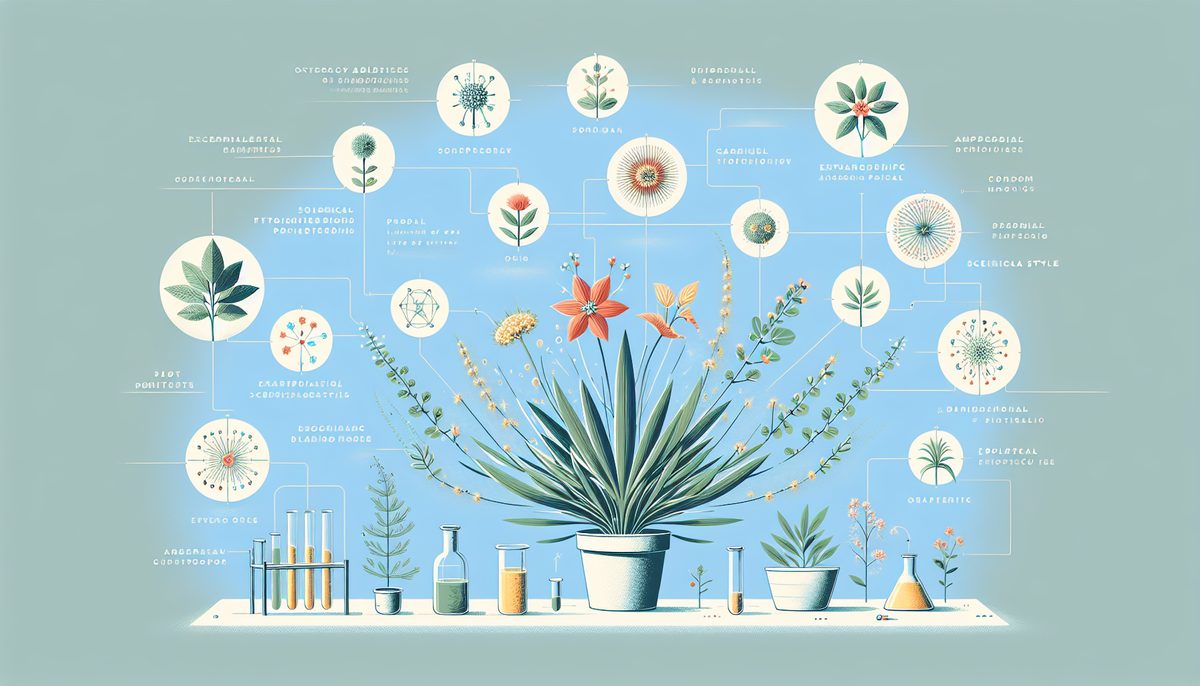6 Astonishing Garden Plants with Superpowers

Introduction: Unveiling Nature's Hidden Superpowers
Plants are far more than just decorative elements in our gardens. They are living laboratories of evolution, honing techniques to survive extreme conditions, fend off predators, and even generate electricity. In this in-depth exploration, we delve into six remarkable garden plants that exhibit extraordinary superpowers. Drawing on insights from gardening expert David Domoney and backed by scientific research, this article highlights the adaptive marvels of these plants—from surviving atomic blasts to employing clever anti-predator strategies. Whether you are a gardening enthusiast, a student of nature, or a science aficionado, prepare to be astonished by the hidden capabilities of these botanical wonders.
1. Atom Bomb Survivors: The Incredible Ginkgo Biloba
The ginkgo biloba tree, often celebrated as a living fossil, has been around for over 175 million years. Its enduring nature is not just a testament to its antiquity, but also to its exceptional resilience. One of the most compelling stories of its survival is linked to the atomic bombing of Hiroshima in 1945. Despite being subjected to intense radiation, severe heat, and physical damage, several ginkgo trees near the bomb's epicenter showed signs of life. Within a year, new shoots began to emerge, symbolizing rebirth and resilience amid devastation.
Key factors behind the ginkgo's incredible durability include:
- Robust cellular repair mechanisms that mitigate radiation damage.
- An intricate root system that helps it absorb nutrients even under stress.
- Genetic traits that have been honed over millions of years of natural selection.
Today, the ginkgo is admired not just for its historical significance but also for its practical benefits. It is commonly planted in urban areas due to its high resistance to pollution and disease, proving that nature often holds the secret to thriving in adverse conditions.
2. Nature’s Antifreeze: The Remarkable Snowdrop (Galanthus Nivalis)
A symbol of hope in the bleak midwinter landscape, the snowdrop is one of the first blooms to appear as winter wanes. But its beauty belies a complex survival strategy that allows it to defy freezing temperatures. Snowdrops produce a unique set of antifreeze proteins that prevent the formation of ice crystals within their cells. This biochemical adaptation is essential for preserving the plant’s cellular integrity even when temperatures plunge well below freezing.
How do snowdrops accomplish this astonishing feat? Consider the following adaptations:
- Antifreeze Proteins: These molecules bind to tiny ice crystals, preventing them from growing large enough to disrupt cell membranes.
- Structural Adaptations: Their slender, pointed foliage aids in breaking through compacted, frozen soil, enabling them to emerge when conditions improve.
- Energy Conservation: Snowdrops have highly efficient metabolic pathways that allow them to thrive on minimal energy during the harsh winter months.
With these ingenious adaptations, the snowdrop not only survives but flourishes when most other plants remain dormant. Its vibrant appearance is a welcome sign that spring is on its way.
3. Plants That Can Count: The Clever Venus Flytrap
The Venus flytrap, famed for its carnivorous tendencies, exhibits one of the most extraordinary behaviors in the plant kingdom—its ability to count. Unlike other passive plants, this carnivorous specimen has developed a mechanism that ensures its traps only close when genuine prey is detected. Tiny hair-like sensors lining the inner surfaces of the trap act as a count system. When an insect brushes against one of these hairs, a potential trigger is set in motion. If a second touch is detected within 30 seconds, the trap swiftly snaps shut to capture the prey.
This sophisticated trigger mechanism is crucial for energy conservation. By 'counting' touches, the Venus flytrap avoids wasting energy on false alarms caused by falling debris or raindrops. The intricate process can be summarized as follows:
- Sensory Detection: Fine hair-like structures detect mechanical stimulation.
- Memory Mechanism: The plant retains a temporary memory of the initial trigger.
- Timed Response: A second stimulation within the brief time window prompts a rapid closure.
This ability not only makes the Venus flytrap an effective predator in nutrient-poor soils but also a fascinating example of how plants have evolved to mimic cognitive functions observed in animals.
4. Botanical Shapeshifter: Holly (Ilex Aquifolium)
Holly is a familiar sight during the winter months, especially during festive seasons. However, its appeal goes beyond ornamental beauty. Holly has a unique adaptive strategy known as heterophylly, where it alters the shape of its leaves in response to herbivorous threats. Under normal conditions, holly leaves are smooth and lush, perfect for maximizing photosynthesis. However, once herbivores start nibbling at the foliage, the plant counterattacks by producing leaves with sharp, spiky edges exactly at the heights where the leaves are most frequently attacked.
This dynamic response serves as an efficient defense mechanism:
- Adaptive Foliage: Smooth leaves transform into sharp blades when under threat.
- Selective Growth: Only the leaves within the reach of herbivores undergo this transformation.
- Deterrence Strategy: The spiky texture deters further feeding by making the leaves less palatable.
This culinary-turned-defensive ability ensures that the holly remains a thriving and protected component of its ecosystem, showcasing nature’s inherent ingenuity in self-preservation.
5. The Vegetable World’s Battery: The Power of the Potato
Often seen as a humble kitchen staple, the potato is surprisingly endowed with the capability to generate electrical energy. This phenomenon, which might remind one of fun classroom experiments, relies on the chemical reactions that occur within the potato when metal electrodes, such as zinc and copper, are inserted. The potato acts as an organic battery, converting stored chemical energy into electrical energy through an electrochemical reaction.
The process works as follows:
- Electrode Insertion: Inserting different metal electrodes creates a voltage difference.
- Chemical Reaction: The natural acids and compounds in the potato interact with the metals to initiate a flow of electrons.
- Energy Release: This flow can power small devices such as light bulbs or LED lights.
In controlled experiments, a well-prepared potato has been shown to power an LED light for several days and, with the right configuration, could even charge a small mobile phone. Though not practical as a primary energy source, this discovery has sparked interest in sustainable energy solutions and bio-batteries. The potato, in this light, becomes a symbol of how everyday objects can harbor untapped scientific potential.
6. Once Touched, Twice Shy: The Sensitive Plant (Mimosa Pudica)
The sensitive plant, Mimosa pudica, is renowned for its rapid, touch-induced movements—a phenomenon that captivates onlookers. When the leaves of this plant are disturbed by even the lightest touch, a cascade of cellular events is triggered. The plant’s cells quickly release potassium and chloride ions, leading to the rapid efflux of water from the cells. This sudden change in turgor pressure causes the leaves to fold inward as a defensive response.
Key aspects of Mimosa pudica’s fascinating behavior include:
- Rapid Response: The leaves fold within seconds of being touched, creating a temporary visual impression of wilting.
- Energy Efficiency: The mechanism is highly efficient, using minimal resources to achieve a protective result.
- Environmental Adaptation: This movement may also serve to reduce damage from heavy winds and errant raindrops.
Interestingly, after the initial movement, the plant gradually resets within minutes, returning to its normal state. This reversible response not only protects Mimosa pudica from potential harm but also illustrates an advanced level of sensitivity and adaptability in the plant kingdom.
Conclusion: The Future of Gardening and Botanical Research
The six plants discussed in this article are prime examples of nature’s ingenuity. From the age-defying resilience of the ginkgo biloba to the energy-generating capabilities of the humble potato, each plant illustrates a unique aspect of survival and adaptation. These extraordinary superpowers are not only fascinating from a scientific perspective but also hold practical lessons for gardeners and researchers. Here are some takeaways:
- Modern gardening can benefit from understanding and harnessing these natural adaptations.
- Urban planners and environmental scientists can look to these plants for sustainable solutions in harsh environments.
- Continued research into plant adaptations may lead to breakthroughs in renewable energy, agriculture, and even robotics.
Furthermore, these discoveries invite us to view our gardens as dynamic ecosystems where every plant plays a role far more complex than mere aesthetic appeal. The advances in botanical science reveal that the boundaries between plant biology and technology are becoming increasingly blurred, setting the stage for a new era of eco-innovation.
Expert Insights and Future Applications
Experts in plant sciences are now exploring ways to adapt these natural mechanisms for human use. For example, the antifreeze proteins found in snowdrops have potential applications in cryopreservation and even in improving cold-weather crop yields. Similarly, the energy storage properties of potatoes are steering research into bio-batteries and sustainable energy alternatives. The Venus flytrap’s counting mechanism is sparking discussions about bio-inspired sensors that could revolutionize robotics and artificial intelligence.
Additionally, the dynamic adaptive features of plants like holly offer intriguing possibilities for material science, such as self-healing surfaces and adaptive coatings. With each discovery, we deepen our understanding of how life thrives against odds, and we open up new avenues for integrating biological innovations into modern technology.
Wrapping Up: Embracing Nature’s Brilliance
Gardening is evolving from a hobby into a scientific journey. The six plants outlined in this article are more than just subjects of curiosity; they are beacons of innovation that remind us of nature's endless ability to innovate. Whether you are tending to a small backyard garden or involved in cutting-edge botanical research, the lessons these plants offer are invaluable. Their superpowers challenge our perceptions of simplicity and reveal a complex world where survival is an art perfected over millennia.
As we continue to explore and understand these natural marvels, one thing becomes abundantly clear: the future of gardening and sustainable technology lies in the careful observation and emulation of these extraordinary life forms. Embrace the science behind the superpowers of everyday plants, and you might just unlock a new world of possibilities in both gardening and beyond.



Comments ()